Opening off-topic remarks (skip)
Hello word! This is my first time to use Markdown editor, and also my first time to write a blog. I am conscious of cultivating good summary habits for myself; second, because I can help others. If there are any mistakes, I hope to point them out. Thank you.
The year of 2019 is an unusual year for science and technology. Huawei is the most brilliant one, taking the lead in mastering 5G technology. A private company dares to fight against the "mad" Trump government. In August, Hongmeng Operating System was released, demonstrating the future of super terminals.
For me, 2019 is the first year of programming. I hope I don't forget the beginning and end well. Like a hot balloon, it keeps rising!
Don't talk too much nonsense, get to the point!
Logistic Regression with a Neural Network mindset
Welcome to your first (required) programming assignment! You will build a logistic regression classifier to recognize cats. This assignment will step you through how to do this with a Neural Network mindset, and so will also hone your intuitions about deep learning.
Instructions:
- Do not use loops (for/while) in your code, unless the instructions explicitly ask you to do so.
You will learn to:
- Build the general architecture of a learning algorithm, including:
- Initializing parameters
- Calculating the cost function and its gradient
- Using an optimization algorithm (gradient descent)
- Gather all three functions above into a main model function, in the right order.
1 - Packages
First, let's run the cell below to import all the packages that you will need during this assignment.
- numpy is the fundamental package for scientific computing with Python.
- h5py is a common package to interact with a dataset that is stored on an H5 file.
- matplotlib is a famous library to plot graphs in Python.
- PIL and scipy are used here to test your model with your own picture at the end.
import numpy as np import matplotlib.pyplot as plt import h5py import scipy from PIL import Image from scipy import ndimage from lr_utils import load_dataset %matplotlib inline
2 - Overview of the Problem set
Problem Statement: You are given a dataset ("data.h5") containing:
- a training set of m_train images labeled as cat (y=1) or non-cat (y=0)
- a test set of m_test images labeled as cat or non-cat
- each image is of shape (num_px, num_px, 3) where 3 is for the 3 channels (RGB). Thus, each image is square (height = num_px) and (width = num_px).
You will build a simple image-recognition algorithm that can correctly classify pictures as cat or non-cat.
Let's get more familiar with the dataset. Load the data by running the following code.
# Loading the data (cat/non-cat) train_set_x_orig, train_set_y, test_set_x_orig, test_set_y, classes = load_dataset() #y is label data
We added "_orig" at the end of image datasets (train and test) because we are going to preprocess them. After preprocessing, we will end up with train_set_x and test_set_x (the labels train_set_y and test_set_y don't need any preprocessing).
We added "orig" at the end of the image data set (training and testing) because we need to preprocess them.
After preprocessing, we will get train set_x and test_set_x (labels train_set_y and test_set_y do not require any preprocessing).
Each line of your train_set_x_orig and test_set_x_orig is an array representing an image. You can visualize an example by running the following code. Feel free also to change the index value and re-run to see other images.
# Example of a picture index = 25 plt.imshow(train_set_x_orig[index]) print ("y = " + str(train_set_y[:, index]) + ", it's a '" + classes[np.squeeze(train_set_y[:, index])].decode("utf-8") + "' picture.")
y = [1], it's a 'cat' picture.
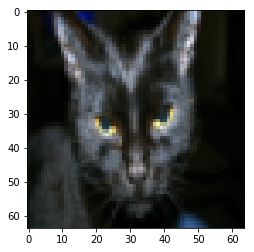
Many software bugs in deep learning come from having matrix/vector dimensions that don't fit. If you can keep your matrix/vector dimensions straight you will go a long way toward eliminating many bugs.
Exercise: Find the values for:
- m_train (number of training examples)
- m_test (number of test examples)
- num_px (= height = width of a training image)
Remember that train_set_x_orig is a numpy-array of shape (m_train, num_px, num_px, 3). For instance, you can access m_train by writing train_set_x_orig.shape[0]. You can access the matrix shape of m_train by writing train_set_x_source. shape [0].
### START CODE HERE ### (≈ 3 lines of code) m_train = None m_test = None num_px = None ### END CODE HERE ### print ("Number of training examples: m_train = " + str(m_train)) print ("Number of testing examples: m_test = " + str(m_test)) print ("Height/Width of each image: num_px = " + str(num_px)) print ("Each image is of size: (" + str(num_px) + ", " + str(num_px) + ", 3)") print ("train_set_x shape: " + str(train_set_x_orig.shape)) print ("train_set_y shape: " + str(train_set_y.shape)) print ("test_set_x shape: " + str(test_set_x_orig.shape)) print ("test_set_y shape: " + str(test_set_y.shape))
Number of training examples: m_train = None Number of testing examples: m_test = None Height/Width of each image: num_px = None Each image is of size: (None, None, 3) train_set_x shape: (209, 64, 64, 3) train_set_y shape: (1, 209) test_set_x shape: (50, 64, 64, 3) test_set_y shape: (1, 50)
Expected Output for m_train, m_test and num_px:
| **m_train** | 209 |
For convenience, you should now reshape images of shape (num_px, num_px, 3) in a numpy-array of shape (num_px * num_px * 3, 1). After this, our training (and test) dataset is a numpy-array where each represents a flattened image. Should be trained (where each test) colu After that, our training (and testing) data set is an array of numbers, each of which represents a flat image. There should be m_train (m_test, respectively)
Exercise: Reshape the training and test data sets so that images of size (num_px, num_px, 3) are flattened into single vectors of shape (num_px * num_px * 3, 1). Reshape training and test data sets to flatten the image of size (num_px, num_px, 3) into a single vector of shape (num_px_px, 3, 1).
A trick when you want to flatten a matrix X of shape (a,b,c,d) to a matrix X_flatten of shape (b∗*∗c∗*∗d, a) is to use:
X_flatten = X.reshape(X.shape[0], -1).T # X.T is the transpose of X
# Reshape the training and test examples ### START CODE HERE ### (≈ 2 lines of code) train_set_x_flatten = train_set_x_orig.reshape(train_set_x_orig.shape[0],-1).T test_set_x_flatten = test_set_x_orig.reshape(test_set_x_orig.shape[0],-1).T ### END CODE HERE ### print ("train_set_x_flatten shape: " + str(train_set_x_flatten.shape)) print ("train_set_y shape: " + str(train_set_y.shape)) print ("test_set_x_flatten shape: " + str(test_set_x_flatten.shape)) print ("test_set_y shape: " + str(test_set_y.shape)) print ("sanity check after reshaping: " + str(train_set_x_flatten[0:5,0]))
train_set_x_flatten shape: (12288, 209) train_set_y shape: (1, 209) test_set_x_flatten shape: (12288, 50) test_set_y shape: (1, 50) sanity check after reshaping: [17 31 56 22 33]
Expected Output:
| **train_set_x_flatten shape** | (12288, 209) |
| **train_set_y shape** | (1, 209) |
| **test_set_x_flatten shape** | (12288, 50) |
| **test_set_y shape** | (1, 50) |
| **sanity check after reshaping** | [17 31 56 22 33] |
To represent color images, the red, green and blue channels (RGB) must be specified for each pixel, and so the pixel value is actually a vector of three numbers ranging from 0 to 255.
One common preprocessing step in machine learning is to center and standardize your dataset, meaning that you substract the mean of the whole numpy array from each example, and then divide each example by the standard deviation of the whole numpy array. But for picture datasets, it is simpler and more convenient and works almost as well to just divide every row of the dataset by 255 (the maximum value of a pixel channel).
A common preprocessing step in machine learning is to centralize and standardize data sets, which means subtracting the average value of the entire numpy array from each example and dividing each example by the standard deviation of the entire numpy array. But for image datasets, dividing each row of the dataset by 255 (the maximum value of the pixel channel) is simpler, more convenient and almost equally effective.Let's standardize our dataset.
**What you need to remember:**train_set_x = train_set_x_flatten/255. test_set_x = test_set_x_flatten/255.
Common steps for pre-processing a new dataset are:
- Figure out the dimensions and shapes of the problem (m_train, m_test, num_px, ...)
- Reshape the datasets such that each example is now a vector of size (num_px * num_px * 3, 1)
- "Standardize" the data
The common steps for preprocessing new data sets are as follows:
Find out the size and shape of the problem (m_train, m_test, num_px,... )
Redefine the dataset so that each example is now a size vector (num_px * num_px * 3,1)
Standardized data
3 - General Architecture of the learning algorithm
It's time to design a simple algorithm to distinguish cat images from non-cat images.
You will build a Logistic Regression, using a Neural Network mindset. The following Figure explains why Logistic Regression is actually a very simple Neural Network!
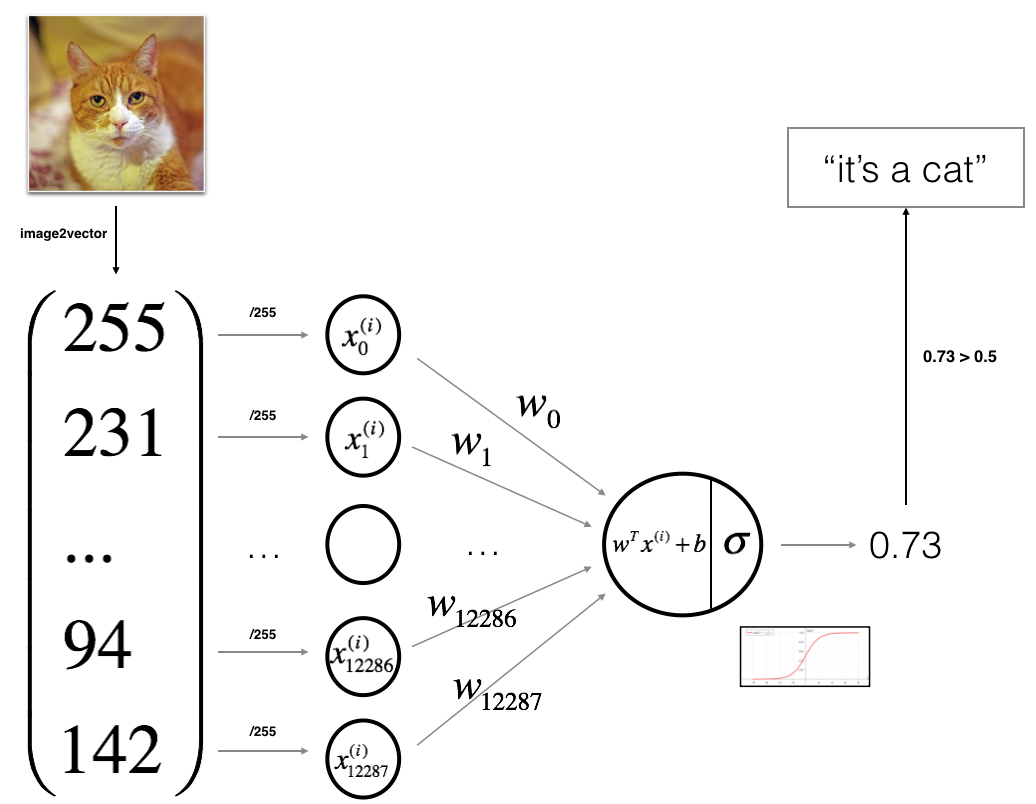
Mathematical expression of the algorithm:
For one example x(i)x^{(i)}x(i):
(1)z(i)=wTx(i)+bz^{(i)} = w^T x^{(i)} + b \tag{1}z(i)=wTx(i)+b(1)
(2)y^(i)=a(i)=sigmoid(z(i))\hat{y}^{(i)} = a^{(i)} = sigmoid(z^{(i)})\tag{2}y^(i)=a(i)=sigmoid(z(i))(2)
(3)L(a(i),y(i))=−y(i)log(a(i))−(1−y(i))log(1−a(i)) \mathcal{L}(a^{(i)}, y^{(i)}) = - y^{(i)} \log(a^{(i)}) - (1-y^{(i)} ) \log(1-a^{(i)})\tag{3}L(a(i),y(i))=−y(i)log(a(i))−(1−y(i))log(1−a(i))(3)
The cost is then computed by summing over all training examples:
(6)J=1m∑i=1mL(a(i),y(i)) J = \frac{1}{m} \sum_{i=1}^m \mathcal{L}(a^{(i)}, y^{(i)})\tag{6}J=m1i=1∑mL(a(i),y(i))(6)
Key steps:
In this exercise, you will carry out the following steps:
- Initialize the parameters of the model
- Learn the parameters for the model by minimizing the cost
- Use the learned parameters to make predictions (on the test set)
- Analyse the results and conclude
4 - Building the parts of our algorithm
The main steps for building a Neural Network are:
- Define the model structure (such as number of input features)
- Initialize the model's parameters
- Loop:
- Calculate current loss (forward propagation)
- Calculate current gradient (backward propagation)
- Update parameters (gradient descent)
The main steps of building a neural network are as follows:
- Define the model structure (such as the number of input features)
- Initialization model parameters
- Cycle:
- Calculate the current loss function (forward propagation)
- Calculate the current gradient (back propagation)
- Updating parameters (gradient descent)
You often build 1-3 separately and integrate them into one function we call model().
You usually build 1 - 3 functions separately and integrate them into a function called model().
4.1 - Helper functions
Exercise: Using your code from "Python Basics", implement sigmoid(). As you've seen in the figure above, you need to compute sigmoid(wTx+b)=11+e−(wTx+b)sigmoid( w^T x + b) = \frac{1}{1 + e^{-(w^T x + b)}}sigmoid(wTx+b)=1+e−(wTx+b)1 to make predictions. Use np.exp().
# GRADED FUNCTION CLASSIFICATION FUNCTION: sigmoid here creates an activation function, equivalent to a subfunction in main function def sigmoid(z): """ Compute the sigmoid of z Arguments: z -- A scalar or numpy array of any size. Return: s -- sigmoid(z) """ ### START CODE HERE ### (≈ 1 line of code) s = 1/(1+np.exp(-z)) ### END CODE HERE ### return s
print ("sigmoid([0,1, 2]) = " + str(sigmoid(np.array([0,1,2]))))
sigmoid([0,1, 2]) = [0.5 0.73105858 0.88079708]
Expected Output:
| **sigmoid([0, 2])** | [ 0.5 0.88079708] |
4.2 - Initializing parameters
Exercise: Implement parameter initialization in the cell below. You have to initialize w as a vector of zeros. If you don't know what numpy function to use, look up np.zeros() in the Numpy library's documentation.
# GRADED FUNCTION: initialize_with_zeros Create a function initialized to 0 here def initialize_with_zeros(dim): """ This function creates a vector of zeros of shape (dim, 1) for w and initializes b to 0. Argument: dim -- size of the w vector we want (or number of parameters in this case) Returns: w -- initialized vector of shape (dim, 1) b -- initialized scalar (corresponds to the bias) """ ### START CODE HERE ### (≈ 1 line of code) w = np.zeros((dim,1)) b = 0 ### END CODE HERE ### assert(w.shape == (dim, 1)) assert(isinstance(b, float) or isinstance(b, int)) return w, b
dim = 2 w, b = initialize_with_zeros(dim) print ("w = " + str(w)) print ("b = " + str(b))
w = [[0.] [0.]] b = 0
Expected Output:
| ** w ** | [[ 0.] [ 0.]] |
| ** b ** | 0 |
For image inputs, w will be of shape (num_px ×\times× num_px ×\times× 3, 1).
4.3 - Forward and Backward propagation
Now that your parameters are initialized, you can do the "forward" and "backward" propagation steps for learning the parameters.
Exercise: Implement a function propagate() that computes the cost function and its gradient.
Hints:
Forward Propagation:
- You get X
- You compute A=σ(wTX+b)=(a(1),a(2),...,a(m−1),a(m))A = \sigma(w^T X + b) = (a^{(1)}, a^{(2)}, ..., a^{(m-1)}, a^{(m)})A=σ(wTX+b)=(a(1),a(2),...,a(m−1),a(m))
- You calculate the cost function: J=−1m∑i=1my(i)log(a(i))+(1−y(i))log(1−a(i))J = -\frac{1}{m}\sum_{i=1}^{m}y^{(i)}\log(a^{(i)})+(1-y^{(i)})\log(1-a^{(i)})J=−m1∑i=1my(i)log(a(i))+(1−y(i))log(1−a(i))
Here are the two formulas you will be using:
(7)∂J∂w=1mX(A−Y)T \frac{\partial J}{\partial w} = \frac{1}{m}X(A-Y)^T\tag{7}∂w∂J=m1X(A−Y)T(7)
(8)∂J∂b=1m∑i=1m(a(i)−y(i)) \frac{\partial J}{\partial b} = \frac{1}{m} \sum_{i=1}^m (a^{(i)}-y^{(i)})\tag{8}∂b∂J=m1i=1∑m(a(i)−y(i))(8)
The loss function first derives z, then Z derives w and b.
# GRADED FUNCTION: propagate propagation function def propagate(w, b, X, Y): """ Implement the cost function and its gradient for the propagation explained above Arguments: w -- weights, a numpy array of size (num_px * num_px * 3, 1) b -- bias, a scalar X -- data of size (num_px * num_px * 3, number of examples) Y -- true "label" vector (containing 0 if non-cat, 1 if cat) of size (1, number of examples) Return: cost -- negative log-likelihood cost for logistic regression dw -- gradient of the loss with respect to w, thus same shape as w db -- gradient of the loss with respect to b, thus same shape as b Tips: - Write your code step by step for the propagation. np.log(), np.dot() """ m = X.shape[1] #Number of 0 rows; Number of 1 columns # FORWARD PROPAGATION (FROM X TO COST) ### START CODE HERE ### (≈ 2 lines of code) #xx=X.shape #ww=w.shape #print(xx) #print(ww) A = sigmoid(np.dot(w.T,X)+b) # compute activation cost = -np.sum(np.dot(Y,np.log(A).T)+np.dot((1-Y),np.log(1-A).T))/m # compute cost where Y and A are both lines, so multiplying requires transposition. ### END CODE HERE ### # BACKWARD PROPAGATION (TO FIND GRAD) ### START CODE HERE ### (≈ 2 lines of code) dw = np.dot(X,(A-Y).T)/m db = np.sum((A-Y)/m) ### END CODE HERE ### assert(dw.shape == w.shape) assert(db.dtype == float) cost = np.squeeze(cost) assert(cost.shape == ()) grads = {"dw": dw, "db": db} return grads, cost
w, b, X, Y = np.array([[1.],[2.]]), 2., np.array([[1.,2.,-1.],[3.,4.,-3.2]]), np.array([[1,0,1]]) grads, cost = propagate(w, b, X, Y) print ("dw = " + str(grads["dw"])) print ("db = " + str(grads["db"])) print ("cost = " + str(cost))
dw = [[0.99845601] [2.39507239]] db = 0.0014555781367842635 cost = 5.801545319394553
Expected Output:
| ** dw ** | [[ 0.99845601] [ 2.39507239]] |
| ** db ** | 0.00145557813678 |
| ** cost ** | 5.801545319394553 |
4.4 - Optimization
- You have initialized your parameters.
- You are also able to compute a cost function and its gradient.
- Now, you want to update the parameters using gradient descent.
Exercise: Write down the optimization function. The goal is to learn www and bbb by minimizing the cost function JJJ. For a parameter θ\thetaθ, the update rule is $ \theta = \theta - \alpha \text{ } d\theta$, where α\alphaα is the learning rate.
# GRADED FUNCTION: Optimized optimization function def optimize(w, b, X, Y, num_iterations, learning_rate, print_cost = False): """ This function optimizes w and b by running a gradient descent algorithm Arguments: w -- weights, a numpy array of size (num_px * num_px * 3, 1) b -- bias, a scalar X -- data of shape (num_px * num_px * 3, number of examples) Y -- true "label" vector (containing 0 if non-cat, 1 if cat), of shape (1, number of examples) num_iterations -- number of iterations of the optimization loop learning_rate -- learning rate of the gradient descent update rule print_cost -- True to print the loss every 100 steps Returns: params -- dictionary containing the weights w and bias b grads -- dictionary containing the gradients of the weights and bias with respect to the cost function costs -- list of all the costs computed during the optimization, this will be used to plot the learning curve. Tips: You basically need to write down two steps and iterate through them: 1) Calculate the cost and the gradient for the current parameters. Use propagate(). 2) Update the parameters using gradient descent rule for w and b. """ costs = [] for i in range(num_iterations): # Cost and gradient calculation (≈ 1-4 lines of code) ### START CODE HERE ### grads,cost = propagate(w, b, X, Y) ### END CODE HERE ### # Retrieve derivatives from grads dw = grads["dw"] db = grads["db"] # update rule (≈ 2 lines of code) ### START CODE HERE ### w -= learning_rate * dw b -= learning_rate * db ### END CODE HERE ### # Record the costs if i % 100 == 0: costs.append(cost) # Print the cost every 100 training iterations if print_cost and i % 100 == 0: print ("Cost after iteration %i: %f" %(i, cost)) params = {"w": w, "b": b} grads = {"dw": dw, "db": db} return params, grads, costs
params, grads, costs = optimize(w, b, X, Y, num_iterations= 100, learning_rate = 0.009, print_cost = False) print ("w = " + str(params["w"])) print ("b = " + str(params["b"])) print ("dw = " + str(grads["dw"])) print ("db = " + str(grads["db"]))
w = [[0.19033591] [0.12259159]] b = 1.9253598300845747 dw = [[0.67752042] [1.41625495]] db = 0.21919450454067657
Expected Output:
<tr> <td> **b** </td> <td> 1.92535983008 </td> </tr> <tr> <td> **dw** </td> <td> [[ 0.67752042]
| **w** | [[ 0.19033591] [ 0.12259159]] |
[ 1.41625495]]
db
0.219194504541
Exercise: The previous function will output the learned w and b. We are able to use w and b to predict the labels for a dataset X. Implement the predict() function. There are two steps to computing predictions:
-
Calculate Y^=A=σ(wTX+b)\hat{Y} = A = \sigma(w^T X + b)Y^=A=σ(wTX+b)
-
Convert the entries of a into 0 (if activation <= 0.5) or 1 (if activation > 0.5), stores the predictions in a vector Y_prediction. If you wish, you can use an if/else statement in a for loop (though there is also a way to vectorize this).
# GRADED FUNCTION: predict ive prediction function def predict(w, b, X): ''' Predict whether the label is 0 or 1 using learned logistic regression parameters (w, b) Arguments: w -- weights, a numpy array of size (num_px * num_px * 3, 1) b -- bias, a scalar X -- data of size (num_px * num_px * 3, number of examples) Returns: Y_prediction -- a numpy array (vector) containing all predictions (0/1) for the examples in X ''' m = X.shape[1] Y_prediction = np.zeros((1,m)) w = w.reshape(X.shape[0], 1) # Compute vector "A" predicting the probabilities of a cat being present in the picture ### START CODE HERE ### (≈ 1 line of code) A = sigmoid(np.dot(w.T,X)+b) ### END CODE HERE ### for i in range(A.shape[1]): # Convert probabilities A[0,i] to actual predictions p[0,i] ### START CODE HERE ### (≈ 4 lines of code) if A[0,i]>0.5: Y_prediction[0,i]=1 else: Y_prediction[0,i]=0 pass ### END CODE HERE ### assert(Y_prediction.shape == (1, m)) return Y_prediction
#This is just testing the code, testing whether the code just compiled has bug s, the data itself is meaningless, only for testing. w = np.array([[0.1124579],[0.23106775]]) b = -0.3 X = np.array([[1.,-1.1,-3.2],[1.2,2.,0.1]]) print ("predictions = " + str(predict(w, b, X)))
predictions = [[1. 1. 0.]]
Expected Output:
| **predictions** | [[ 1. 1. 0.]] |
5 - Merge all functions into a model
You will now see how the overall model is structured by putting together all the building blocks (functions implemented in the previous parts) together, in the right order.
Exercise: Implement the model function. Use the following notation:
- Y_prediction_test for your predictions on the test set
- Y_prediction_train for your predictions on the train set
- w, costs, grads for the outputs of optimize()
# GRADED FUNCTION: model def model(X_train, Y_train, X_test, Y_test, num_iterations = 2000, learning_rate = 0.5, print_cost = False): """ Builds the logistic regression model by calling the function you've implemented previously Arguments: X_train -- training set represented by a numpy array of shape (num_px * num_px * 3, m_train) Y_train -- training labels represented by a numpy array (vector) of shape (1, m_train) X_test -- test set represented by a numpy array of shape (num_px * num_px * 3, m_test) Y_test -- test labels represented by a numpy array (vector) of shape (1, m_test) num_iterations -- hyperparameter representing the number of iterations to optimize the parameters learning_rate -- hyperparameter representing the learning rate used in the update rule of optimize() print_cost -- Set to true to print the cost every 100 iterations Returns: d -- dictionary containing information about the model. """ ### START CODE HERE ### # initialize parameters with zeros (≈ 1 line of code) w, b = initialize_with_zeros(X_train.shape[0]) #The rows of X represent input neurons, and the columns represent the number of images. # Gradient descent (≈ 1 line of code) parameters, grads, costs = optimize(w, b, X_train, Y_train, num_iterations, learning_rate, print_cost) # Retrieve parameters w and b from dictionary "parameters" w = parameters["w"] b = parameters["b"] # Predict test/train set examples (≈ 2 lines of code) Y_prediction_test = predict(w, b, X_test) Y_prediction_train = predict(w, b, X_train) ### END CODE HERE ### # Print train/test Errors print("train accuracy: {} %".format(100 - np.mean(np.abs(Y_prediction_train - Y_train)) * 100)) print("test accuracy: {} %".format(100 - np.mean(np.abs(Y_prediction_test - Y_test)) * 100)) d = {"costs": costs, "Y_prediction_test": Y_prediction_test, "Y_prediction_train" : Y_prediction_train, "w" : w, "b" : b, "learning_rate" : learning_rate, "num_iterations": num_iterations} return d
Run the following cell to train your model.
d = model(train_set_x, train_set_y, test_set_x, test_set_y, num_iterations = 2000, learning_rate = 0.005, print_cost = True)
Cost after iteration 0: 0.693147 Cost after iteration 100: 0.584508 Cost after iteration 200: 0.466949 Cost after iteration 300: 0.376007 Cost after iteration 400: 0.331463 Cost after iteration 500: 0.303273 Cost after iteration 600: 0.279880 Cost after iteration 700: 0.260042 Cost after iteration 800: 0.242941 Cost after iteration 900: 0.228004 Cost after iteration 1000: 0.214820 Cost after iteration 1100: 0.203078 Cost after iteration 1200: 0.192544 Cost after iteration 1300: 0.183033 Cost after iteration 1400: 0.174399 Cost after iteration 1500: 0.166521 Cost after iteration 1600: 0.159305 Cost after iteration 1700: 0.152667 Cost after iteration 1800: 0.146542 Cost after iteration 1900: 0.140872 train accuracy: 99.04306220095694 % test accuracy: 70.0 %
Expected Output:
<tr>
<td> **Cost after iteration 0 ** </td>
<td> 0.693147 </td>
</tr>
<tr>
<td> <center> $\vdots$ </center> </td>
<td> <center> $\vdots$ </center> </td>
</tr>
<tr>
<td> **Train Accuracy** </td>
<td> 99.04306220095694 % </td>
</tr>
<tr>
<td>**Test Accuracy** </td>
<td> 70.0 % </td>
</tr>
Comment: Training accuracy is close to 100%. This is a good sanity check: your model is working and has high enough capacity to fit the training data. Test error is 68%. It is actually not bad for this simple model, given the small dataset we used and that logistic regression is a linear classifier. But no worries, you'll build an even better classifier next week!
Also, you see that the model is clearly overfitting the training data. Later in this specialization you will learn how to reduce overfitting, for example by using regularization. Using the code below (and changing the index variable) you can look at predictions on pictures of the test set.
# Example of a picture that was wrongly classified. index = 1 plt.imshow(test_set_x[:,index].reshape((64, 64, 3))) print ("y = " + str(test_set_y[0,index]) + ", you predicted that it is a \"" + classes[int(d["Y_prediction_test"][0,index])].decode("utf-8") + "\" picture.")
y = 1, you predicted that it is a "cat" picture.
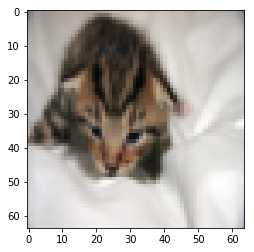
Let's also plot the cost function and the gradients.
# Plot learning curve (with costs) costs = np.squeeze(d['costs']) #np.squeeze() deletes a single dimension entry from the shape of the array, i.e. removes the dimension of 1 from the shape. For example, change the matrix whose shape is (1, 5, 3) to (5, 3) plt.plot(costs) plt.ylabel('cost') plt.xlabel('iterations (per hundreds)') plt.title("Learning rate =" + str(d["learning_rate"])) plt.show()
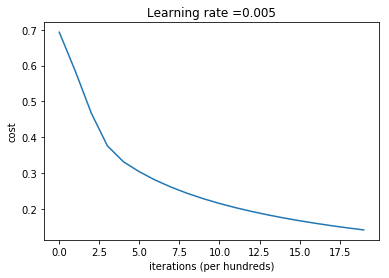
Interpretation:
You can see the cost decreasing. It shows that the parameters are being learned. However, you see that you could train the model even more on the training set. Try to increase the number of iterations in the cell above and rerun the cells.
Overfitting Definition: You may see that training set accuracy goes up, but the test set accuracy goes down. This is called overfitting.
6 - Further analysis (optional/ungraded exercise)
Congratulations on building your first image classification model. Let's analyze it further, and examine possible choices for the learning rate α\alphaα.
Choice of learning rate
Reminder:
In order for Gradient Descent to work you must choose the learning rate wisely. The learning rate α\alphaα determines how rapidly we update the parameters. If the learning rate is too large we may "overshoot" the optimal value. Similarly, if it is too small we will need too many iterations to converge to the best values. That's why it is crucial to use a well-tuned learning rate.
Let's compare the learning curve of our model with several choices of learning rates. Run the cell below. This should take about 1 minute. Feel free also to try different values than the three we have initialized the learning_rates variable to contain, and see what happens.
learning_rates = [0.01, 0.001, 0.0001] models = {} for i in learning_rates: print ("learning rate is: " + str(i)) models[str(i)] = model(train_set_x, train_set_y, test_set_x, test_set_y, num_iterations = 1500, learning_rate = i, print_cost = False) print ('\n' + "-------------------------------------------------------" + '\n') for i in learning_rates: plt.plot(np.squeeze(models[str(i)]["costs"]), label= str(models[str(i)]["learning_rate"])) plt.ylabel('cost') plt.xlabel('iterations (hundreds)') #The plt.legend() function adds legends to the image, and the loc parameter sets the display position of legends. legend = plt.legend(loc='upper center', shadow=True) frame = legend.get_frame() #Returns the square object where legend resides frame.set_facecolor('0.90') plt.show()
learning rate is: 0.01 train accuracy: 99.52153110047847 % test accuracy: 68.0 % ------------------------------------------------------- learning rate is: 0.001 train accuracy: 88.99521531100478 % test accuracy: 64.0 % ------------------------------------------------------- learning rate is: 0.0001 train accuracy: 68.42105263157895 % test accuracy: 36.0 % -------------------------------------------------------
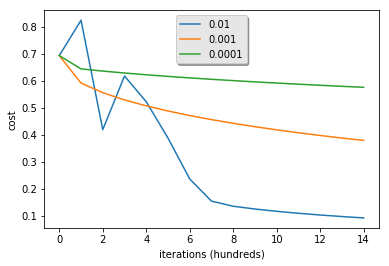
Interpretation:
- Different learning rates give different costs and thus different predictions results.
- If the learning rate is too large (0.01), the cost may oscillate up and down. It may even diverge (though in this example, using 0.01 still eventually ends up at a good value for the cost).
- A lower cost doesn't mean a better model. You have to check if there is possibly overfitting. It happens when the training accuracy is a lot higher than the test accuracy.
- In deep learning, we usually recommend that you:
- Choose the learning rate that better minimizes the cost function.
- If your model overfits, use other techniques to reduce overfitting. (We'll talk about this in later videos.)
7 - Test with your own image (optional/ungraded exercise)
Congratulations on finishing this assignment. You can use your own image and see the output of your model. To do that:
1. Click on "File" in the upper bar of this notebook, then click "Open" to go on your Coursera Hub.
2. Add your image to this Jupyter Notebook's directory, in the "images" folder
3. Change your image's name in the following code
4. Run the code and check if the algorithm is right (1 = cat, 0 = non-cat)!
## START CODE HERE ## (PUT YOUR IMAGE NAME) my_image = "u=1820154701,1076679668&fm=5.jpg" # change this to the name of your image file ## END CODE HERE ## num_px=64 # We preprocess the image to fit your algorithm. fname = "images/" + my_image #File path = folder + image name image = np.array(ndimage.imread(fname, flatten=False)) my_image = scipy.misc.imresize(image, size=(num_px,num_px)).reshape((1, num_px*num_px*3)).T my_predicted_image = predict(d["w"], d["b"], my_image) plt.imshow(image) print("y = " + str(np.squeeze(my_predicted_image)) + ", your algorithm predicts a \"" + classes[int(np.squeeze(my_predicted_image)),].decode("utf-8") + "\" picture.")
y = 0.0, your algorithm predicts a "non-cat" picture. C:\ProgramData\Anaconda3\lib\site-packages\ipykernel_launcher.py:7: DeprecationWarning: `imread` is deprecated! `imread` is deprecated in SciPy 1.0.0. Use ``matplotlib.pyplot.imread`` instead. import sys C:\ProgramData\Anaconda3\lib\site-packages\ipykernel_launcher.py:8: DeprecationWarning: `imresize` is deprecated! `imresize` is deprecated in SciPy 1.0.0, and will be removed in 1.3.0. Use Pillow instead: ``numpy.array(Image.fromarray(arr).resize())``.
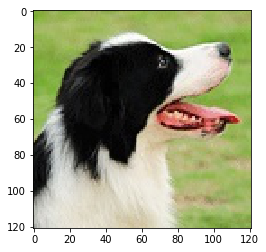
Finally, if you'd like, we invite you to try different things on this Notebook. Make sure you submit before trying anything. Once you submit, things you can play with include:
- Play with the learning rate and the number of iterations
- Try
What to remember from this assignment:
- Preprocessing the dataset is important.
- You implemented each function separately: initialize(), propagate(), optimize(). Then you built a model().
- Tuning the learning rate (which is an example of a "hyperparameter") can make a big difference to the algorithm. You will see more examples of this later in this course! different initialization methods and compare the results
- Test other preprocessings (center the data, or divide each row by its standard deviation)
Bibliography:
- http://www.wildml.com/2015/09/implementing-a-neural-network-from-scratch/
- https://stats.stackexchange.com/questions/211436/why-do-we-normalize-images-by-subtracting-the-datasets-image-mean-and-not-the-c